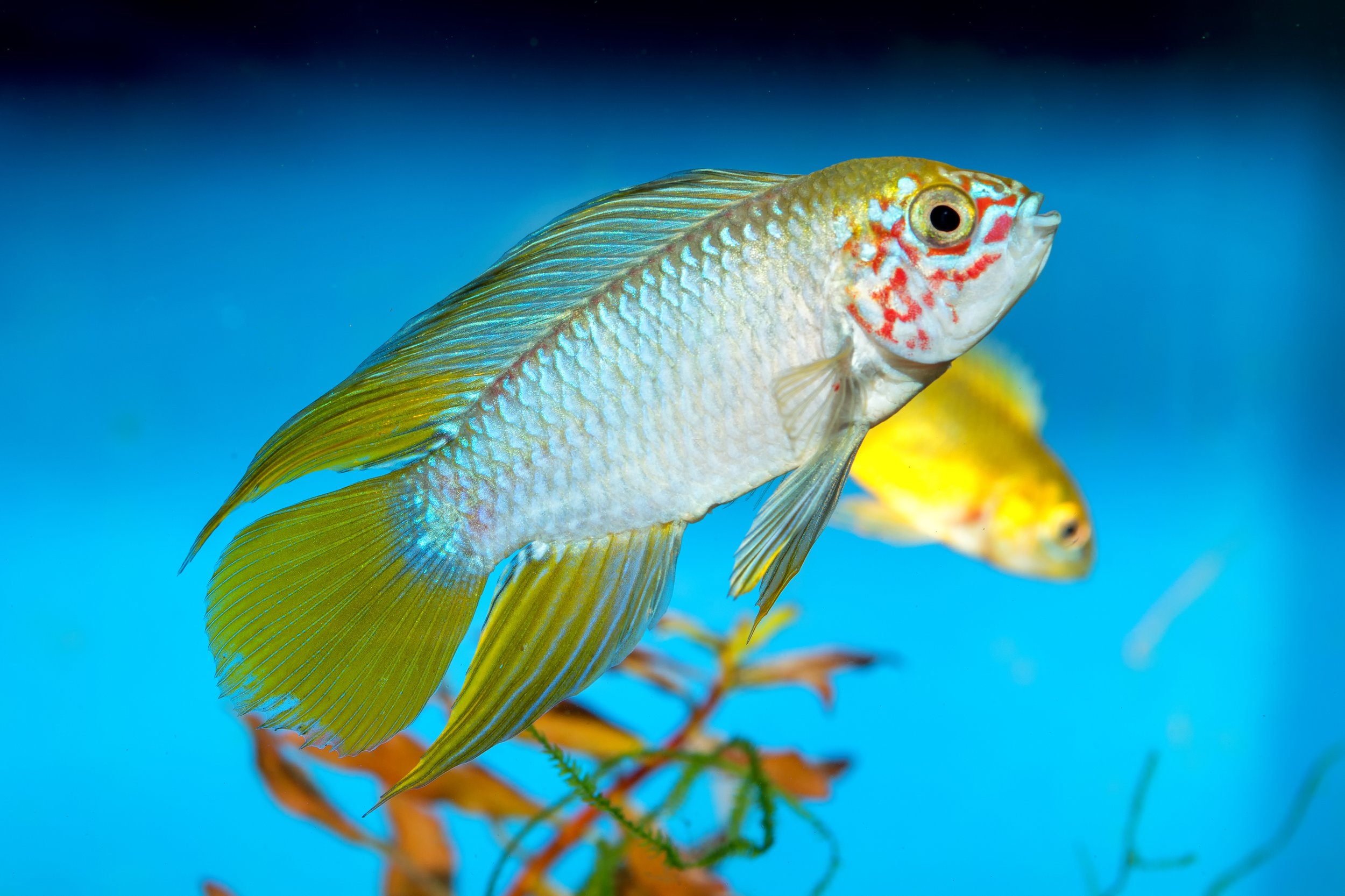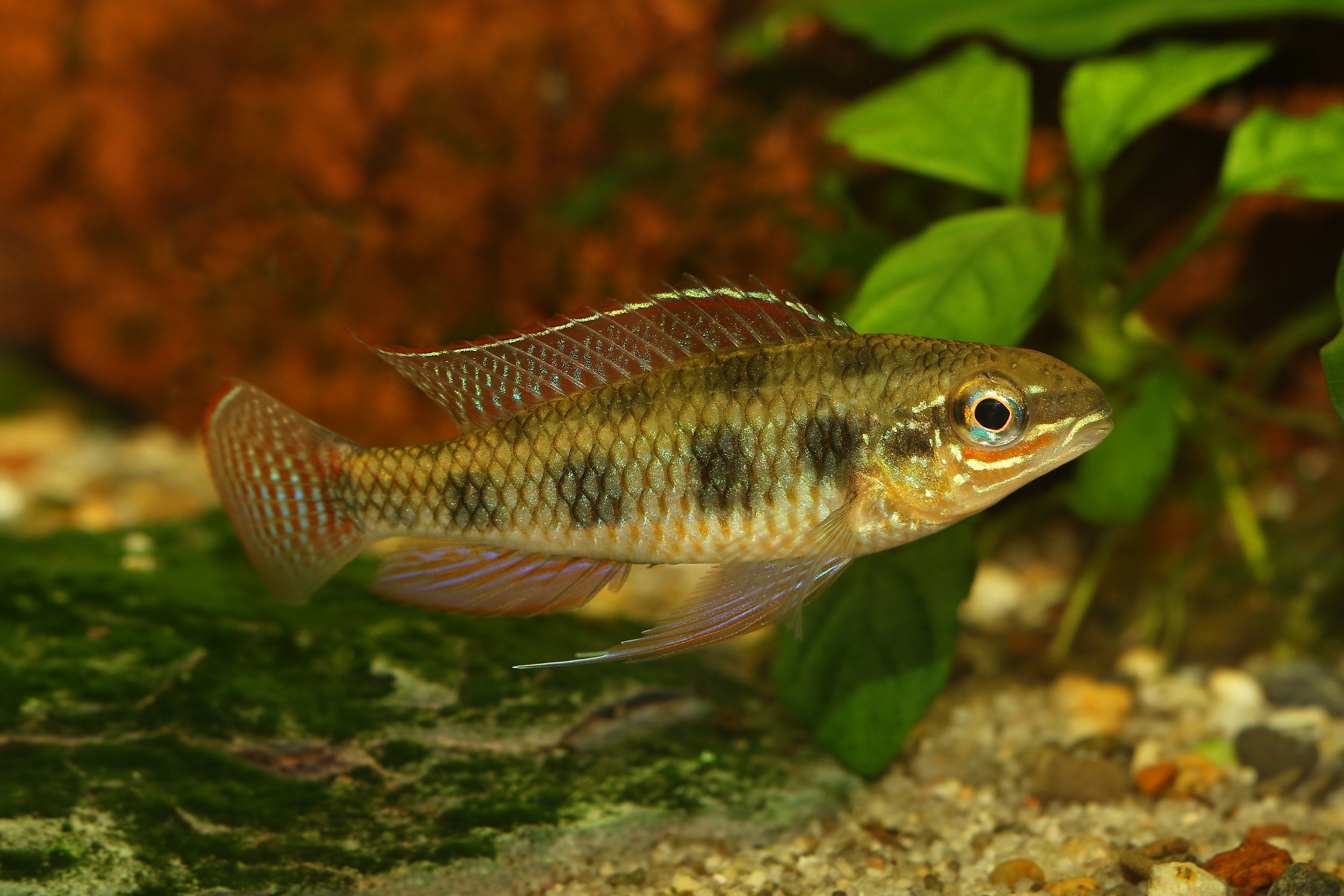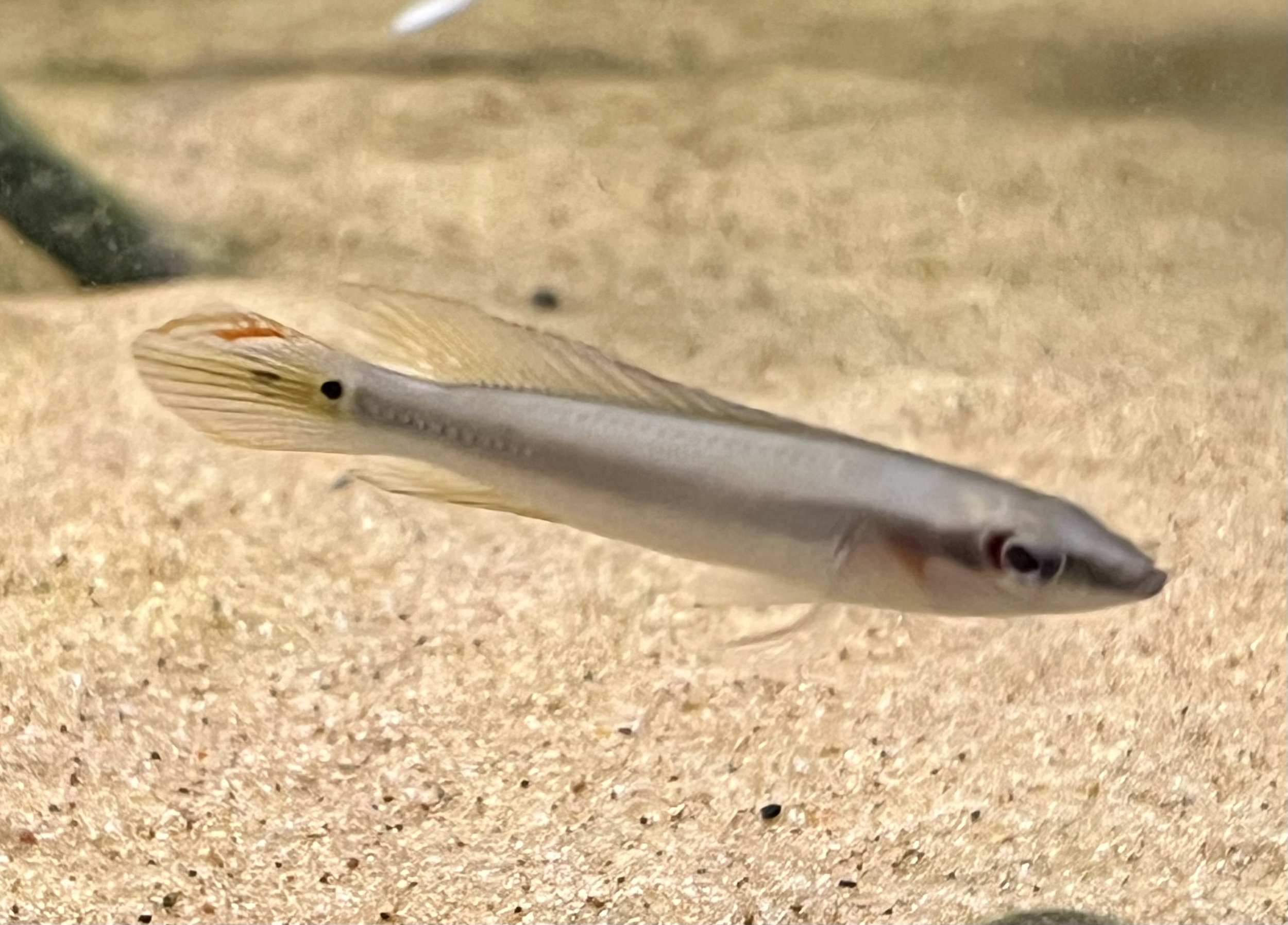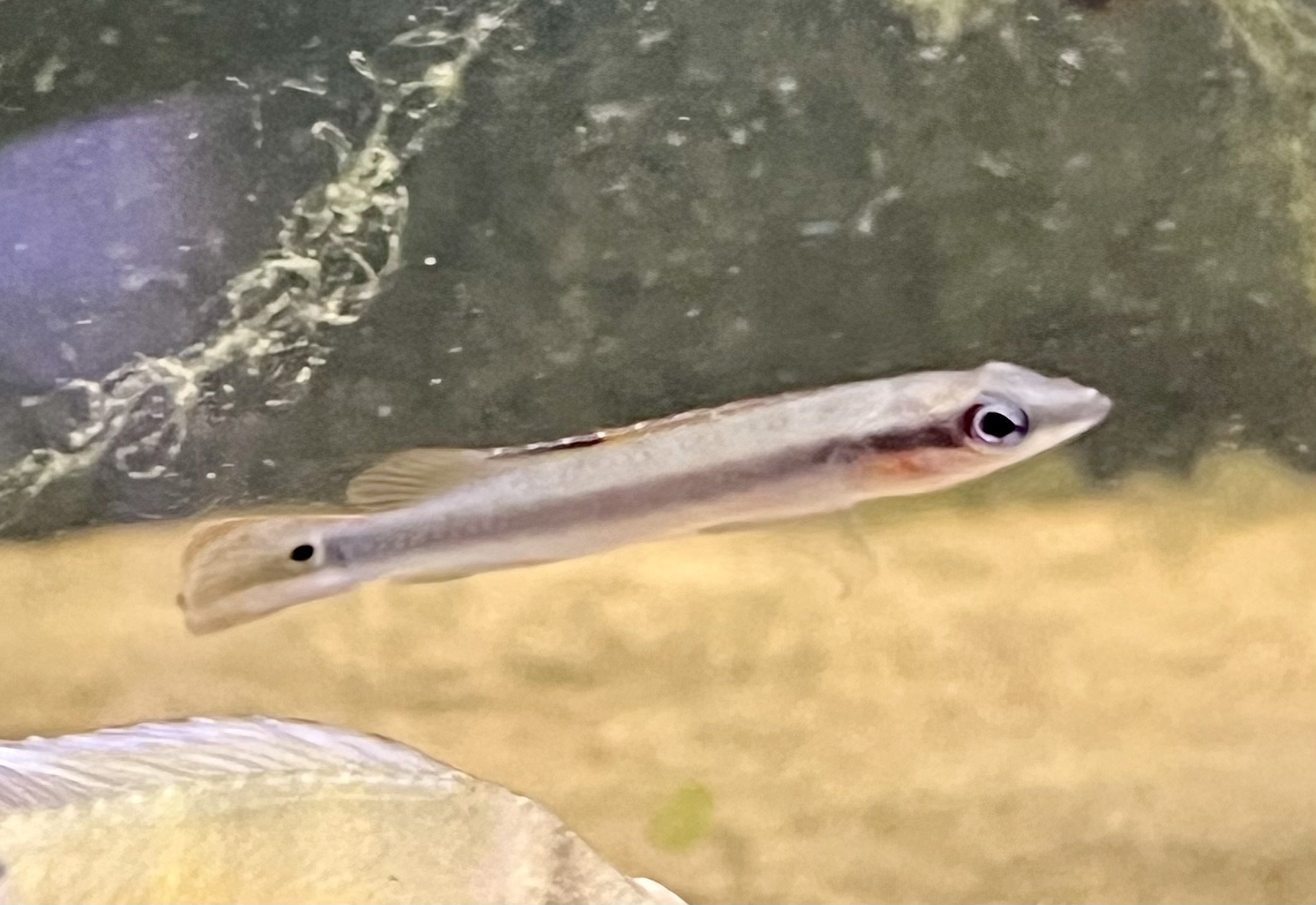 Image 1 of 2
Image 1 of 2

 Image 2 of 2
Image 2 of 2



Red Head Tapajos Geophagus-3-4"
The Red Head Tapajos, scientifically known as Geophagus sp. “Red Head Tapajos”, is a beautifully colored and relatively peaceful South American cichlid found in the Tapajós River basin, a clearwater tributary of the Amazon River in Brazil. It is one of the most popular eartheaters in the aquarium hobby due to its vibrant coloration, manageable size, and compatibility with a variety of tankmates.
Adults typically reach about 6 to 7 inches (15 to 18 cm) in length, with males growing larger and displaying more vivid coloration. Mature specimens feature a bright reddish-orange to cherry red coloration on the head and upper body, which contrasts with their silvery-gold flanks and iridescent blue or green spangling along the sides. Fins are often laced with red and turquoise, and males may develop elongated dorsal and anal fin extensions.
In the aquarium, Geophagus sp. “Red Head Tapajos” does best in a tank of at least 75 gallons, with open swimming space, a sandy substrate for sifting, and a few flat stones or driftwood for structure. As an eartheater, it spends much of its time picking up mouthfuls of sand and filtering it through its gills, so sharp or coarse substrates should be avoided. They are generally peaceful for cichlids, making them suitable for community tanks with other South American species of similar size and temperament.
Water conditions should include a temperature range of 78 to 84°F (25 to 29°C), a pH between 6.0 and 7.5, and soft to moderately hard water. Consistent water quality is important—regular water changes and strong filtration are recommended due to their sensitivity to nitrates and water fouling.
Red Head Tapajos are omnivores and should be fed a varied diet that includes high-quality sinking pellets, frozen or live foods like bloodworms, brine shrimp, and occasional vegetable matter such as spirulina or blanched greens. Their foraging behavior makes them efficient tank cleaners, but they still require dedicated feeding to thrive.
Breeding is achievable in captivity. These fish are biparental mouthbrooders: after courtship and egg-laying on a flat surface, one or both parents (usually the female) will collect the eggs in their mouth for incubation. Fry are released after about 2–3 weeks and can be fed baby brine shrimp and crushed flake food.
Overall, Geophagus sp. “Red Head Tapajos” is a peaceful, attractive, and intelligent cichlid species ideal for intermediate aquarists interested in South American biotope or community setups. Its graceful movement, unique sand-sifting behavior, and fiery coloration make it a standout centerpiece in any well-maintained aquarium.
The Red Head Tapajos, scientifically known as Geophagus sp. “Red Head Tapajos”, is a beautifully colored and relatively peaceful South American cichlid found in the Tapajós River basin, a clearwater tributary of the Amazon River in Brazil. It is one of the most popular eartheaters in the aquarium hobby due to its vibrant coloration, manageable size, and compatibility with a variety of tankmates.
Adults typically reach about 6 to 7 inches (15 to 18 cm) in length, with males growing larger and displaying more vivid coloration. Mature specimens feature a bright reddish-orange to cherry red coloration on the head and upper body, which contrasts with their silvery-gold flanks and iridescent blue or green spangling along the sides. Fins are often laced with red and turquoise, and males may develop elongated dorsal and anal fin extensions.
In the aquarium, Geophagus sp. “Red Head Tapajos” does best in a tank of at least 75 gallons, with open swimming space, a sandy substrate for sifting, and a few flat stones or driftwood for structure. As an eartheater, it spends much of its time picking up mouthfuls of sand and filtering it through its gills, so sharp or coarse substrates should be avoided. They are generally peaceful for cichlids, making them suitable for community tanks with other South American species of similar size and temperament.
Water conditions should include a temperature range of 78 to 84°F (25 to 29°C), a pH between 6.0 and 7.5, and soft to moderately hard water. Consistent water quality is important—regular water changes and strong filtration are recommended due to their sensitivity to nitrates and water fouling.
Red Head Tapajos are omnivores and should be fed a varied diet that includes high-quality sinking pellets, frozen or live foods like bloodworms, brine shrimp, and occasional vegetable matter such as spirulina or blanched greens. Their foraging behavior makes them efficient tank cleaners, but they still require dedicated feeding to thrive.
Breeding is achievable in captivity. These fish are biparental mouthbrooders: after courtship and egg-laying on a flat surface, one or both parents (usually the female) will collect the eggs in their mouth for incubation. Fry are released after about 2–3 weeks and can be fed baby brine shrimp and crushed flake food.
Overall, Geophagus sp. “Red Head Tapajos” is a peaceful, attractive, and intelligent cichlid species ideal for intermediate aquarists interested in South American biotope or community setups. Its graceful movement, unique sand-sifting behavior, and fiery coloration make it a standout centerpiece in any well-maintained aquarium.
The Red Head Tapajos, scientifically known as Geophagus sp. “Red Head Tapajos”, is a beautifully colored and relatively peaceful South American cichlid found in the Tapajós River basin, a clearwater tributary of the Amazon River in Brazil. It is one of the most popular eartheaters in the aquarium hobby due to its vibrant coloration, manageable size, and compatibility with a variety of tankmates.
Adults typically reach about 6 to 7 inches (15 to 18 cm) in length, with males growing larger and displaying more vivid coloration. Mature specimens feature a bright reddish-orange to cherry red coloration on the head and upper body, which contrasts with their silvery-gold flanks and iridescent blue or green spangling along the sides. Fins are often laced with red and turquoise, and males may develop elongated dorsal and anal fin extensions.
In the aquarium, Geophagus sp. “Red Head Tapajos” does best in a tank of at least 75 gallons, with open swimming space, a sandy substrate for sifting, and a few flat stones or driftwood for structure. As an eartheater, it spends much of its time picking up mouthfuls of sand and filtering it through its gills, so sharp or coarse substrates should be avoided. They are generally peaceful for cichlids, making them suitable for community tanks with other South American species of similar size and temperament.
Water conditions should include a temperature range of 78 to 84°F (25 to 29°C), a pH between 6.0 and 7.5, and soft to moderately hard water. Consistent water quality is important—regular water changes and strong filtration are recommended due to their sensitivity to nitrates and water fouling.
Red Head Tapajos are omnivores and should be fed a varied diet that includes high-quality sinking pellets, frozen or live foods like bloodworms, brine shrimp, and occasional vegetable matter such as spirulina or blanched greens. Their foraging behavior makes them efficient tank cleaners, but they still require dedicated feeding to thrive.
Breeding is achievable in captivity. These fish are biparental mouthbrooders: after courtship and egg-laying on a flat surface, one or both parents (usually the female) will collect the eggs in their mouth for incubation. Fry are released after about 2–3 weeks and can be fed baby brine shrimp and crushed flake food.
Overall, Geophagus sp. “Red Head Tapajos” is a peaceful, attractive, and intelligent cichlid species ideal for intermediate aquarists interested in South American biotope or community setups. Its graceful movement, unique sand-sifting behavior, and fiery coloration make it a standout centerpiece in any well-maintained aquarium.







